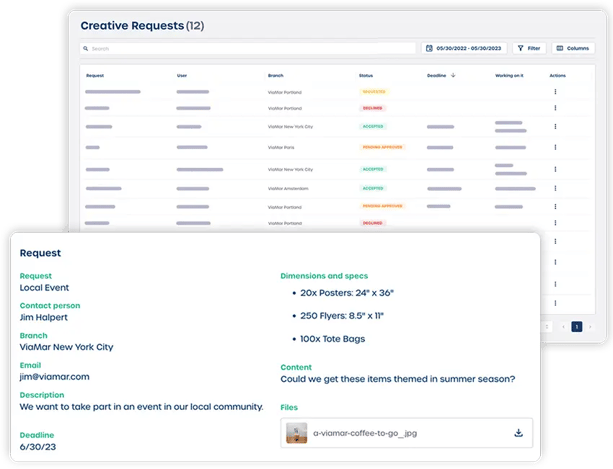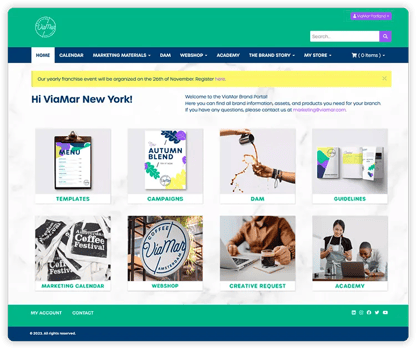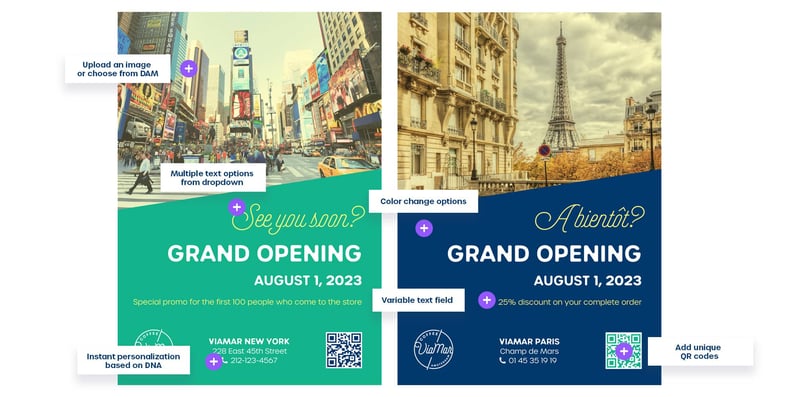.jpg?width=300&name=how%20to%20beat%20one%20off%20marketing%20requests%20header%20(1).jpg)
How to manage one-off marketing requests: 4 proven strategies for success
Last updated: May 15, 2024
Updated on May 15, 2024
As a seasoned marketing professional, you are well-acquainted with the never-ending stream of ad-hoc demands coming from your local teams, sales representatives, and various stakeholders.“Can you resize that ad for our local newspaper?” “Urgent: Need a social post for tomorrow's local event!” These ad-hoc demands can feel like death by a thousand paper cuts, slowly draining your team's productivity and morale.
 You're not alone in this struggle. A recent survey found that 58% of corporate marketers field requests for custom marketing materials from local partners weekly, with 26% facing these requests daily. The impact is real: countless hours diverted from strategic initiatives, inconsistent local messaging, and a strained relationship between HQ and local teams.
You're not alone in this struggle. A recent survey found that 58% of corporate marketers field requests for custom marketing materials from local partners weekly, with 26% facing these requests daily. The impact is real: countless hours diverted from strategic initiatives, inconsistent local messaging, and a strained relationship between HQ and local teams.
But there's hope. By implementing the right strategies and tools, you can take control of one-off requests and unlock your team's potential. In this blog, we'll share four proven tactics for minimizing ad-hoc demands and empowering your local partners.
Understanding the impact of one-off requests
Before we dive into solutions, let's take a closer look at the toll these requests can take:
-
Lost productivity: Every hour spent on an unplanned request is an hour not spent on critical campaigns and initiatives. For a team of 10 marketers, even 5 hours per week per person translates to 2,600 hours per year - that's 325 lost workdays!
-
Opportunity cost: When your team is bogged down with one-off requests, they can't devote their full energy to high-impact work like developing your marketing strategy, analyzing campaign performance, or exploring innovative tactics.
-
Inconsistent local messaging: Without proper guardrails, one-off requests often lead to off-brand messaging and visuals in local markets. This drip-drip effect slowly erodes your brand identity and confuses customers.
-
Strained relationships: The constant back-and-forth between the central marketing team and local partners can breed resentment on both sides. Local partners feel unsupported, while HQ feels unappreciated.
Real-world examples of ad-hoc requests
To crystalize the challenge, here are some common examples of one-off marketing requests:
- Editing a brochure with updated contact info or hours for a specific location
- Resizing social media images to fit different platform specs
- Localizing an ad campaign with market-specific imagery or translations
- Creating a one-time flyer for a local charity event
- Pulling analytics for a single location's campaign performance
4 Strategies to beat one-off marketing requests
Ready to take action? Here are four tactics to minimize ad-hoc demands and empower your local teams:
1. Find the right balance of planned vs. reactive work
Eliminating one-off requests entirely isn't realistic. But you can reduce their impact by proactively allocating time for them.
- Analyze past requests to estimate demand (e.g. 10 hours per week)
- Build this "reactive" time into your team's schedule, alongside planned projects
- Adjust the ratio as needed based on request volume
- Communicate the plan to stakeholders so they know when to expect support
Tools like Asana or Monday can help you track planned vs. unplanned work to strike the right balance.

2. Centralize requests in one place
Chasing down requests across email, Slack, sticky notes, and hallway chats is a recipe for missed deadlines and duplicate work. Consolidating all requests into a single intake system is a game-changer.
By designating one place for housing all incoming requests, your team can efficiently prioritize and assign work without missing a beat. An additional benefit is that your stakeholders will be kept informed of the ongoing status and the designated person responsible for managing the request.
 Marvia Creative Workflow feature
Marvia Creative Workflow feature
3. Empower local teams with a self-service portal
What if local partners could get the assets they need without bombarding you with emails? Enter the self-serve marketing portal.
- Choose a brand management portal or distributed marketing platform
- Organize approved assets like logos, images, and templates for easy search
- Set user or group permissions to control access and editing rights
- Enable on-brand customization with templates (more on that below)
A self-serve brand portal streamlines communication, allowing local teams to swiftly access, personalize, and distribute the necessary content without the hassle of endless email exchanges.

4. Automate your content creation with dynamic templates
Editable templates are a powerful way to maintain brand standards while giving local teams the flexibility to personalize content either manually or (partially) automated. Look for a brand templating tool that supports:
- Web-based editing (preferably WISIWYG)
- Lockable elements to preserve core brand components
- Customizable fields for text, images, colors, etc.
- User-friendly interface for non-designers
- Approval workflows to ensure compliance
- Direct distribution options such as Social Media or printer integrations.
- Bonus points: automatically loads custom data into templates (e.g. contact data, prices, product feeds).
With smart templates, one-off requests for routine localizations become a thing of the past. Local teams can create on-brand, customized assets in minutes, not days.
→ Dive deeper into the ROI of dynamic brand templates

The business impact of streamlined one-off requests
By implementing these four strategies, leading brands have seen significant results like:
- Reduced volume of one-off marketing requests
- Time savings for the corporate marketing team
- Faster local asset production and time-to-market
- Increased local marketing output and effectiveness
- Improved satisfaction and collaboration among local partners
But the value goes beyond hard numbers. When you minimize ad-hoc interruptions, your team is free to focus on the strategic, proactive work that drives real business growth. And when you empower your local partners with efficient self-service tools, you build a positive culture of trust and collaboration across your organization.
From chaos to consistency
Managing one-off requests can feel like an uphill battle, but it doesn't have to be that way. By balancing planned and reactive work, centralizing intake, enabling self-service, and automating with templates, you can dramatically reduce ad-hoc demands.
It's not just about efficiency - it's about unlocking your team's full potential and building more authentic connections with local customers. When everyone has the tools and processes to create effective, on-brand marketing, your entire organization wins.
Ready to take control of one-off marketing requests? Use this checklist to get started:
✓ Analyze your current ratio of planned vs. reactive work
✓ Choose a request intake and management tool
✓ Set up a self-service portal for approved assets
✓ Implement dynamic templates for key content types
✓ Train your team and local partners on the new systems
✓ Regularly review and optimize your process
With the right strategies and tools, you can transform one-off requests from a drain on resources to an opportunity for growth. Embrace the change and watch your team thrive!
Ready to take control of one-off marketing requests and unlock your team's potential? See how Marvia's platform can help you streamline workflows, empower local partners and drive better results.
> Request your free demo today and start working smarter, not harder!
